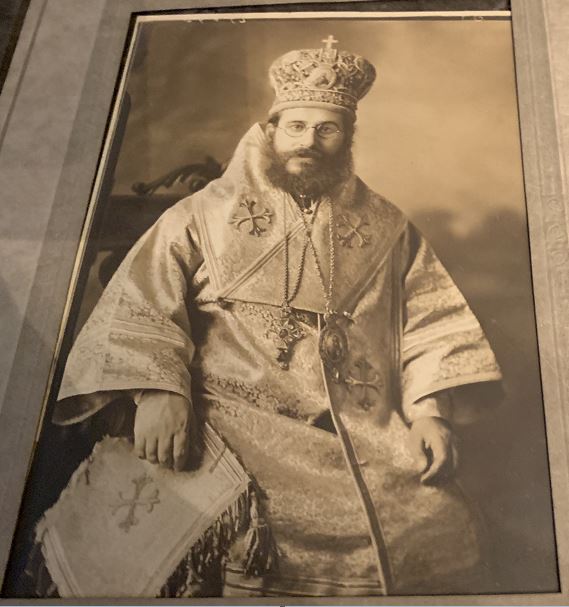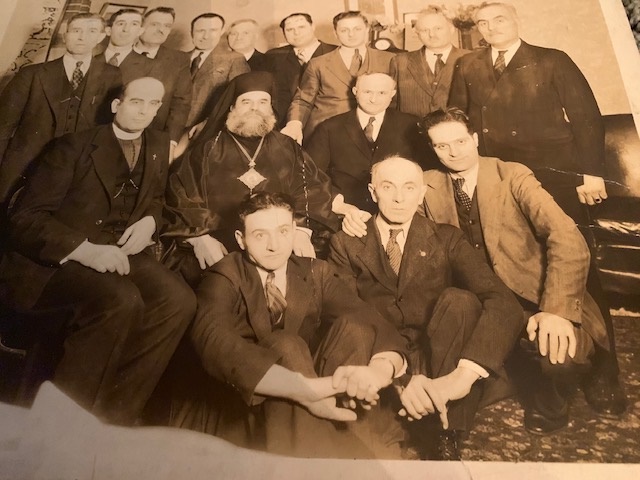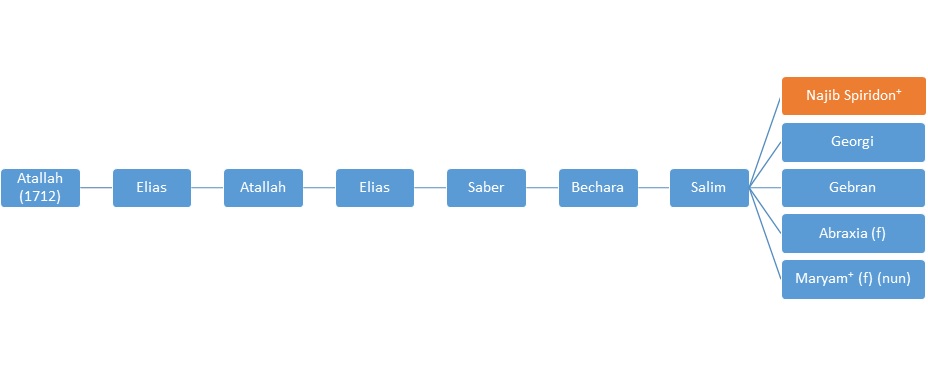Patriarch Theodosius IV Abou Rjeily (1885-1970)
Patriarch Theodosius VI Abou Rjeily served as the Greek Orthodox Patriarch of Antioch and All the East from 1958 to 1970.
His full name was Najib Spiridon Salim Bechara Saber Elias Atallah Elias Atallah Abou Rjeily.
He had five siblings: two sisters and two brothers. His siblings included Maryam, a nun at the Monastery of Saint Mary in Ashrafieh, Lebanon; Abraxia, who was married; and Georgi and Gebran.
Najib Spiridon was raised in the Orthodox Christian faith within the Church of Antioch. He was born in Arsoun, Metn, Mount Lebanon, near Salima village, in 1885. In 1887, his family moved to Ashrafieh, Beirut, Lebanon.
 |
 |
|
Theodosius VI Abou Rjeily, Greek Orthodox patriarch of Antioch and all the East |
Patriarch Theodosius VI Abou Rjeily surrounded by Lebanese immigrants to the USA. To his right, Anthony Bashir, the Metropolitan Archbishop of America. In the back row, the sixth from the left, Mr. William Samuel Bourjaily (1898-1976). Picture taken in 1936 |

Spiridon received his early education at the elementary school "Ecole des Trois Docteurs" in Ashrafieh, Beirut, and continued his studies at the Kasibiya school in Damascus, Syria. Later, he joined the theological school at the Monastery of Our Lady of Balamand in Tripoli, North Lebanon.
During his studies, he felt a strong vocation for the monastic life. He moved to Damascus, where he lived in the patriarchal monastery under the guidance of Patriarch Meletius II (Doumani). He continued his studies at the Orthodox Syriac School in Damascus. The patriarch noticed his intelligence and sincerity and perceived that he might eventually become a priest. At an unknown date in Damascus, Patriarch Meletius tonsured Spiridon as a monk, giving him the name Theodosius.
The Monk Theodosius (Abou Rjeily) was then sent to the Balamand Monastery for further formation and education. At the monastery, he replaced the cotton mattress in his cell with one stuffed with straw, demonstrating humility. He showed equal respect to both students and teachers. At that time, the seminary at the Balamand Monastery flourished, producing many students who went on to serve the Church. Among his older companions were notable figures like Antonius Moubayed of Homs, Mikhail Siyoufi of Damascus, and Mikhail Shehada of Kuspa (later of Homs). Due to his good behavior, attention to his studies, and consistently high grades, Theodosius earned the respect of both teachers and students.
- In 1905, The Monk Theodosius (Abou Rjeily) was ordained to the Holy Diaconate by Metropolitan Gregory (Haddad) of Tripoli.
- In 1908, Hierodeacon Theodosius (Abou Rjeily) was transferred to the Archdiocese of Diyarbakir in Southeastern Turkey to assist Metropolitan Sylvester (Zerouni). There, he also learned the Turkish language. The diocese of the Church of Antioch still existed at that time. After the repose of Archbishop Sylvester, he remained in the diocese. After Archbishop Matthias (Qatni) was elected to the Diyarbakir diocese in 1912, Theodosius returned to Damascus and resumed his studies.
- In 1912, he was sent to Constantinople (Istanbul) to advance his theological education. He first received a degree from a school in Istanbul and then studied at the Halki Theological Seminary of the Patriarchate of Constantinople on the Island of Halki. At that time, Aristokles Spyrou (later Ecumenical Patriarch Athenagoras) was also a student there. During this period, Hierodeacon Theodosius improved his Greek language skills.
- In 1914, Hierodeacon Theodosius (Abou Rjeily) was assigned to serve as a representative of the Church of Antioch to the Church of Greece in Athens.
- Also in 1914, Hierodeacon Theodosius was appointed as a liaison officer between the Antiochian Patriarchate and the Turkish government, serving Orthodox Christian communities in both Syria and Lebanon.
- In 1915, Hierodeacon Theodosius successfully completed all his studies in Istanbul and Halki and returned to Damascus.
- In 1915, Hierodeacon Theodosius (Abou Rjeily) was ordained to the Holy Priesthood by Patriarch Gregory IV (Haddad). The patriarch immediately elevated him to the rank of archimandrite. Archimandrite Theodosius (Abou Rjeily) became the personal secretary to Patriarch Gregory IV, earning the nickname "the translator" due to his language skills. By this time, he was fluent in Arabic, French, Greek, Turkish, and Syriac, with a working knowledge of English and Russian. He was responsible for translating among these languages at the patriarchate.
- The Diocese of Tyre and Sidon, and its dependencies, experienced a severe financial crisis. After Bishop Elias (Dib) obtained a travel permit from Patriarch Gregory to go abroad for fundraising, Archimandrite Theodosius (Abou Rjeily) was assigned to administer the diocese. However, after some time, the Holy Synod received a message from Bishop Elias stating that he had chosen to remain in Chile and would not return to the Diocese of Tyre and Sidon.
- In 1923, Archimandrite Theodosius (Abou Rjeily) was elected by the Holy Synod of the Church of Antioch to become a bishop. He was ordained to the Holy Episcopate by Patriarch Gregory IV and the bishops of the Church of Antioch. Bishop Theodosius was appointed Metropolitan Archbishop of the Diocese of Tyre and Sidon in South Lebanon. He was the sixth bishop of this diocese, following the first bishop, Anastasius, in 1583. He held this position for 25 years.
- On October 27-28, 1931, Metropolitan Theodosius (Abou Rjeily) represented the Antiochian Orthodox Church at the Orthodox-Old Catholic Conference in Bonn, Germany.
- In 1935–1936, on behalf of Patriarch Alexander III (Tahan), Metropolitan Theodosius made a tour of the parishes of the Antioch Orthodox Church in the USA. During this time, he played a key role in guiding the election of a new archbishop for the Syrian Orthodox in North America, resulting in the election and episcopal ordination of Metropolitan Antony (Bashir) of New York City.
- On April 19, 1936, Archimandrite Antony (Bashir) was ordained to the Holy Episcopate in the Cathedral of Saint Nicholas in Brooklyn, New York, by Metropolitan Theodosius (Abou Rjeily) of the Diocese of Tyre, Sidon, and Dependencies, together with Archbishop Vitaly (Maximenko). Despite agreements on unity, divisions persisted for a time. Nevertheless, the work that Metropolitan Theodosius accomplished under Patriarch Alexander III (Tahan) established a firm foundation for the Antiochian Archdiocese and laid the groundwork for future reconciliations.
- In 1945, Metropolitan Theodosius (Abou Rjeily) accompanied Patriarch Alexander III (Tahan) on a visit to the Church of Russia in the Soviet Union for the enthronement of Patriarch Alexei I (Simansky).
- In 1948, Metropolitan Theodosius was transferred by the Holy Synod of the Church of Antioch to lead the Archdiocese of Tripoli and al-Koura in Lebanon. Metropolitan Theodosius was an exemplary and faithful shepherd, prioritizing worship and nurturing the diocese he led. During his episcopal service, many activities and projects were undertaken in Tripoli, North Lebanon. Several associations were established in the diocese, including the Association of the Orthodox Faith Soldiers. Schools such as Al-Islah in Amioun and the Orthodox "Al-Qayyah" were also established. He built and restored many churches, including the Church of Saint Michael and the Church of Saint John the Baptist in Kfar Aaqa. During the last years of Patriarch Alexander III's life, Metropolitan Theodosius became the oldest member of the episcopate of the Antioch Orthodox Church. As the senior bishop, he led the celebrations of the 50th anniversary of Patriarch Alexander's episcopacy in 1953.
- In September 1954, Metropolitan Theodosius again accompanied Patriarch Alexander III (Tahan) on a visit to the Church of Russia in the Soviet Union. Patriarch Alexander was among several heads of Orthodox Churches who wrote to the Soviet authorities to request an end to the harsh treatment of the Russian Orthodox Church by the Soviet State. These letters contributed to a change in the state's attitude, which occurred in November 1954.
- On June 17, 1958, after the repose of Patriarch Alexander III (Tahan), Metropolitan Theodosius (Abou Rjeily) was appointed by the Holy Synod of Antioch to serve as the Locum Tenens of the Patriarchal Throne of Antioch.
- On November 14, 1958, Metropolitan Theodosius was elected and enthroned as Patriarch Theodosius VI (Abou Rjeily) of Antioch at the Mariamite Cathedral in Damascus, following Patriarch Alexander's death on June 17, 1958.
- Patriarch Theodosius VI became known as such because he was the sixth Patriarch of Antioch since Apostolic times to bear the name Theodosius. His official title was Patriarch Theodosius VI (Abou Rjeily) of Antioch and All the East. The physical territory of the Patriarchate of Antioch included Syria, Lebanon (the political distinction between Syria and Lebanon was introduced in the 20th century), Jordan, and Iraq (Mesopotamia). Beyond this territory, "All the East" included the Arabian Peninsula and beyond (historically, this included Persia, India, and China). Since the emigration of the 20th century, the patriarchal pastoral responsibility expanded to include "non-territorial" Archdioceses and Exarchates, which were in their early stages of development abroad: Australia and New Zealand, Central America, North America, South America, and Western Europe.
- In 1960, Patriarch Alexei I (Simansky) of Moscow and All Rus' awarded Patriarch Theodosius an honorary doctorate degree from the Moscow Theological Academy during the Russian Patriarch's visit to Damascus.
- Patriarch Theodosius visited the Church of Bulgaria and Patriarch Kyril (Konstantinov) in 1960. During his visits in 1961 to the heads of the Autocephalous Churches of Constantinople, Moscow, Czechoslovakia, and Greece, the Patriarch of Constantinople asked Patriarch Theodosius to mediate between the Churches of Constantinople and Bulgaria to find an understanding between the two Churches. After negotiations involving the Churches of Constantinople, Russia, and Bulgaria, the desired understanding was achieved. As a result, the Patriarchate of Constantinople recognized the legality of the independence of the Orthodox Church in Bulgaria, an outcome eagerly awaited by the heads of the Churches, especially the Bulgarian Patriarch Kyril. Thus, the Patriarch of Antioch played an important and pivotal role in inter-Orthodox relations worldwide.
- Patriarch Theodosius founded the Patriarchal Museum in 1961, which includes manuscripts, books, collectibles, and precious items. The Patriarchal Library was organized by Dr. Najeeb Mikhael Al-Sahati, director of the Institute of Greek Studies in Alexandria, who cataloged the manuscripts, books, sources, and references. Patriarch Theodosius laid the foundation stone of the first Saint John Theological Institute (Balamand) in Lebanon and the Middle East. Metropolitan Antony (Bashir) of New York and North America donated the funds for its creation. Patriarch Theodosius engaged in similar activities, including the construction of churches and Orthodox schools in Damascus. He re-published the magazine "The Journal of Grace" in 1959, which had not been published since 1914.
- In 1961, Patriarch Theodosius (Abou Rjeily) sent a delegation representing the Antiochian Orthodox Church to the First Pan-Orthodox Consultation in Rhodes, Greece. The delegation included Bishop Ignatius (Hiraika) of Hama, Bishop Alexandros (Geha) of Homs, Archbishop Elias (Muawad) of Aleppo, and Dr. Najeeb Mikhael Al-Sahati.
- On March 18, 1962, Patriarch Theodosius VI (Abou Rjeily), together with bishops of the Holy Synod of Antioch, ordained Archimandrite Elias (Kourban) to the Holy Episcopate. He was assigned as the Metropolitan of the Archdiocese of Tripoli, al-Koura, and Dependencies in Lebanon. He had been ordained to the Holy Diaconate by Patriarch Alexander III (Tahan) and to the Holy Priesthood by Metropolitan Antony (Bashir). In addition to his written works, Metropolitan Elias (Kourban) led a material and spiritual renaissance in the Archdiocese of Tripoli, which included establishing or renovating many parishes, schools, technical institutes, charitable organizations, centers for the mentally disabled, homes for the elderly, health centers, and a school of church music.
- In 1962, Patriarch Theodosius visited Patriarch Kyril (Markov) of Sofia and All Bulgaria, leading a high-level delegation. In 1963, Patriarch Theodosius toured the diocese of the Church of Antioch.
- On August 14, 1966, Patriarch Theodosius VI (Abou Rjeily), together with bishops of the Holy Synod of Antioch, ordained Archimandrite Philip (Saliba) of the Antiochian Orthodox Christian Archdiocese of North America to the Holy Episcopate at the Patriarchal Monastery of the Prophet Elias in Dhour El Choueir, Lebanon. Metropolitan Philip (Saliba) later became the head of the Antiochian Orthodox Christian Archdiocese of North America, serving capably and productively for over 40 years.
- On September 15, the patriarch returned to visit the Monastery of Saint Elias (Shwayya) in the Metn District.
- In February 1967, Patriarch Theodosius met with Armenian Orthodox Patriarch Vazgen I (Baljian) and the “Standing Committee of the Eastern Churches” Conference, the predecessor of the Middle East Council of Churches. During his tenure as patriarch, clergy were sent to Canada to serve the main centers of Syrian and Lebanese settlement, including Halifax, Charlottetown, Montréal, Ottawa, Toronto, and Windsor. Newcomers to Canada began settling in the Western Provinces as well, forming distinct communities apart from the other Orthodox Christian parishes in which they worshiped. One of the patriarch’s nephews became a Hierodeacon and later a Hieromonk in Canada.
- On September 19, 1970, Patriarch Theodosius VI (Abou Rjeily) reposed in Christ at Saint George’s Hospital in Ashrafieh, Beirut. The Funeral Services for the Burial of a Hierarch were conducted by the Bishops of the Holy Synod of Antioch and others at the Mariamite Cathedral in Damascus. After the funeral services, his body was interred in the Patriarchate Cemetery of the Mariamite Cathedral in Damascus.
- Patriarch Theodosius VI was preceded by Patriarch Alexander III (Tahan) and succeeded by Patriarch Elias IV (Muawad).
- His Beatitude was fluent in Arabic, French, Greek, and Turkish, and had a working knowledge of English and Russian.
- As Patriarch of Antioch and All the East, His Beatitude Theodosius VI had spiritual jurisdiction over 1,500,000 Orthodox Christians, primarily in Syria and Lebanon, with large communities in North, Central, and South America, as well as Australia.